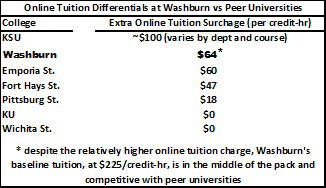An in-depth look at differing credit hour rates at WU: Part 2 of 2
January 2, 2013
In October the first part of this series gathered students’ reactions to higher online tuition rates. Some students did not mind paying $192 more for a 3-hour course. Some students preferred taking classroom courses for the in-person interaction and access to professors. However, others, especially in the nursing program, were faced with no classroom alternatives to certain online courses. This last group of students felt strongly that their online courses cost them much more and delivered an inferior learning experience.
This second article discusses online courses from the perspective of the university, and it takes into account cost considerations.
Washburn’s $64/hr surcharge for online courses is high among its peer institutions. Only Kansas State University, with a surcharge of $100, charges a higher differential.
But charging an online premium is not uncommon among universities in Kansas and in the United States. Training faculty in the use of online technology and offering help desk support are the driving factors behind the surcharge, according to faculty and administrators interviewed for this article.
Angel is currently Washburn’s online course management system, and the university is taking bids to replace Angel with another system beginning with the next academic calendar year.
According to Stewart Murphy, Director of Online Education, Angel and any online system requires more tech support and training for faculty.
“With classroom courses, professors might just elect to put up some files. But in an online course you have to replace all the elements that happen in the classroom, such as discussion, submitting assignments and returning them graded, the online quizzing, and the communications between professor and student,” said Murphy. “So yes, there are more activities and tools, and therefore more training and support.”
Faculty investment of time and labor is another factor, according to information provided by Nancy Tate, Assistant Vice President for Academic Affairs. A typical online course saves a professor two-and-a-half hours per week standing and lecturing in the classroom. But the same online course also adds 10 hours per week for the professor to read and to respond to students’ posts, concerns, and inquiries.
By contrast, in a classroom setting these concerns can be handled more efficiently, as a professor can answer common concerns for students all at once.
Rob Hull, professor of finance, teaches an online course in the business school. He said the biggest time investment involves the learning curve associated with changing online technology.
“The startup time of training for online courses is greater, but if you can teach the same course for at least three years then it begins to consume less time. But the biggest deterrent to teaching an online course is the constantly changing technology,” said Hull, referring to online course management systems, such as the upcoming termination of Angel and the adoption of a new system. “When they do this, it is like starting all over again because you basically have to start the course from scratch.”
For Kerry Wynn, professor of history, her online courses involve the same investment of time but a different allocation of that time.
“For an online course once I’ve posted lectures, I don’t have to deliver them, so in that way it is less work. I write the lectures, and while I re-evaluate them every time I teach the course, I don’t have to standup and deliver 50-minute lectures,” said Wynn.
At the same time, Wynn finds she is slowed by assignments, which are submitted online.
“The grading actually takes longer online. For me it’s much faster to write than it is to type. So I’m much faster at reading, marking, and making comments on papers when they’re in [hardcopy] form,” said Wynn. “So for online courses, the tasks are different and the workload is allocated differently, but the time commitment is the same.”
Although Washburn, among its peer universities in Kansas, charges a high online premium, Washburn’s baseline tuition of $225/credit-hr places Washburn in the middle of the pack.
This fact encourages university bursar Richard Selden. Selden handles collection of tuition money and disbursement of university funds, and he is largely removed from setting online tuition rates and from discerning additional costs required for online education.
But as the bursar, Selden compares the cost of a Washburn education to those of its peers, and he believes Washburn students are receiving value for their tuition money. The baseline tuition, he believes, is a significant reason for this.
“Overall, Washburn provides an excellent value in the learning experience, and the part I’m very happy about is that a Washburn education is affordable when it’s compared with the other universities in our state,” said Selden.



